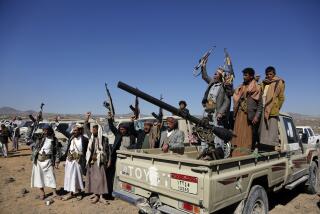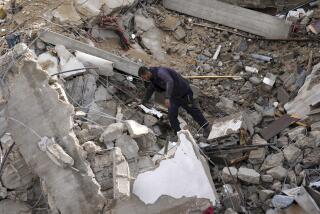Tripoli chaos raises fear of missiles going to terrorists
In November 2002, Al Qaeda-affiliated terrorists fired two shoulder-launched missiles at a chartered Israeli passenger jet as it took off from Mombasa, Kenya.
Both shots missed, but it was an unnerving reminder that portable surface-to-air missiles have hit 40 civilian aircraft since 1975, mostly in war zones, causing 28 crashes and killing more than 800 people, according to a State Department report.
The collapse of Moammar Kadafi’s regime in Libya has prompted fear that terrorists may obtain shoulder-fired missiles from Libyan weapons depots, just as Iraqi insurgents pilfered arsenals after the U.S.-led invasion in 2003.
Pentagon officials have estimated that Kadafi’s forces had 20,000 portable missiles. Most are Soviet-made SA-7s from the 1970s, however, and may not be operational. But a Russian company recently said that it had sold Kadafi’s military an unspecified number of SA-24s, which are more modern.
The Obama administration has urged Libyan rebels to secure the depots and is cautioning nearby countries to watch for missiles or other munitions being smuggled across their borders.
Some evidence suggests that has happened.
In April, Chad’s president, Idriss Deby, said a cache of surface-to-air missiles and launchers from Libya had been smuggled to Al Qaeda’s African affiliate, Al Qaeda in the Islamic Maghreb. Algerian officials have given similar accounts.
U.S. officials have not publicly confirmed the smuggling reports, but Pentagon spokesman Dave Lapan said Libyan missiles are a concern because of their portability.
“Together with the State Department, we are working with our allies and partners in the region to help prevent the proliferation of Libya’s inventory of shoulder-fired antiaircraft missiles,” he said Thursday.
The State Department has awarded $3 million to two humanitarian groups — the British branch of the Mines Advisory Group and the Swiss Foundation for Mine Action — to help clear weapons, mines and munitions in rebel-held parts of Libya.
The Libyan conflict has limited the groups’ access, however, and spokesmen for the two groups said that, as of Thursday, they had found and destroyed only four missiles, which are called Man-Portable Air Defense Systems.
Libya has at least 523 arms bunkers, said Valeria Fabbroni of the Swiss Foundation for Mine Action. The rebels have tried to put up fences and post guards as they capture sites, but the challenge is “massive,” she said.
“I think the risk is significant because the forces controlling Libya right now are not well organized, they’re not well disciplined, they don’t have formal security protocols,” said J. Christian Kessler, who retired in 2008 as head of the State Department’s Office of Conventional Arms Threat Reduction. “My guess is that the closest thing they have to inventory on ammo is, ‘Nuts, we’re getting low, find some more.’”
“We need to assume that X percent of the inventory will leak,” he said. “Where it leaks to, how badly it leaks, those are guesses.”
Terrorists have never downed a commercial airliner with a portable missile. But insurgent groups have shot down a chartered helicopter and cargo planes in Iraq and Somalia in recent years.
In 2002, Abu Huzifa, an Al Qaeda operative from Sudan, acknowledged firing an SA-7 at a U.S. military plane as it took off from Prince Sultan Air Base in Saudi Arabia. It missed, and he was later arrested.
The missile was from the same production batch that was used in the failed attack against the Israeli aircraft later that year in Kenya, investigators determined.
More to Read
Start your day right
Sign up for Essential California for news, features and recommendations from the L.A. Times and beyond in your inbox six days a week.
You may occasionally receive promotional content from the Los Angeles Times.







